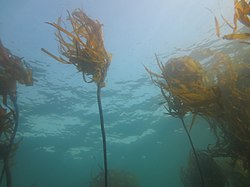- Bull kelp ( Nereocystis luetkeana ) at Caspar Point, California
- Southern bull kelps ( Durvillaea ) in Otago, New Zealand
This article needs additional citations for verification .(September 2025) |
Bull kelp is a common name for the brown alga Nereocystis luetkeana [1] [2] which is a true kelp in the family Laminariaceae. It grows in coastal waters. [3] It ranges from Unimak Island, Alaska, and California, but there is more of it north of San Francisco. [2]
Species in the genus Durvillaea are also sometimes called "bull kelp". Durvillaea is a genus in the order Fucales and, though superficially similar in appearance, is not a true kelp (all of which are in the order Laminariales).

